Audit Planning and Analysis of Seven Accounts: A Comprehensive Report
VerifiedAdded on 2020/03/07
|10
|2122
|96
Report
AI Summary
This report provides a comprehensive audit planning and analysis of seven key accounts for Fulvous Enterprises. It begins with an overview of audit planning, including analytical review and preliminary judgment of materiality. The report then delves into a detailed examination of each account: bank loan, interest income, miscellaneous expenses, accounts receivable, interest expense, inventory, and depreciation. For each account, the rationale for selection, assertions made by the auditor, and recommended audit procedures are presented. The analysis includes a review of the company's financial statements, focusing on areas of potential risk and the need for specific audit steps. The report also references relevant accounting standards and provides supporting financial statements in the appendix, offering a practical guide to audit procedures and financial statement analysis. This student assignment is designed to provide a practical understanding of audit processes and the analysis of key financial statement components.
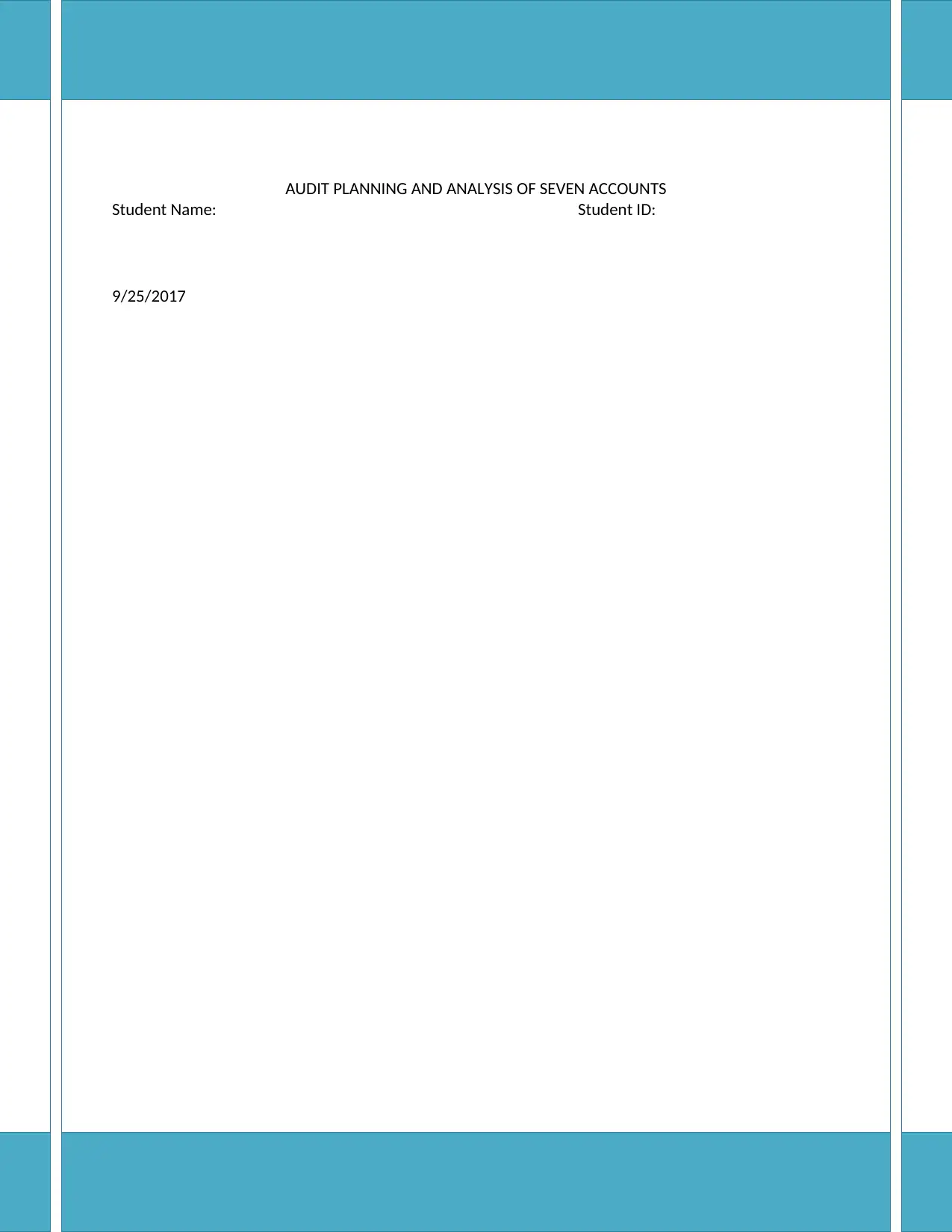
AUDIT PLANNING AND ANALYSIS OF SEVEN ACCOUNTS
Student Name: Student ID:
9/25/2017
Student Name: Student ID:
9/25/2017
Paraphrase This Document
Need a fresh take? Get an instant paraphrase of this document with our AI Paraphraser
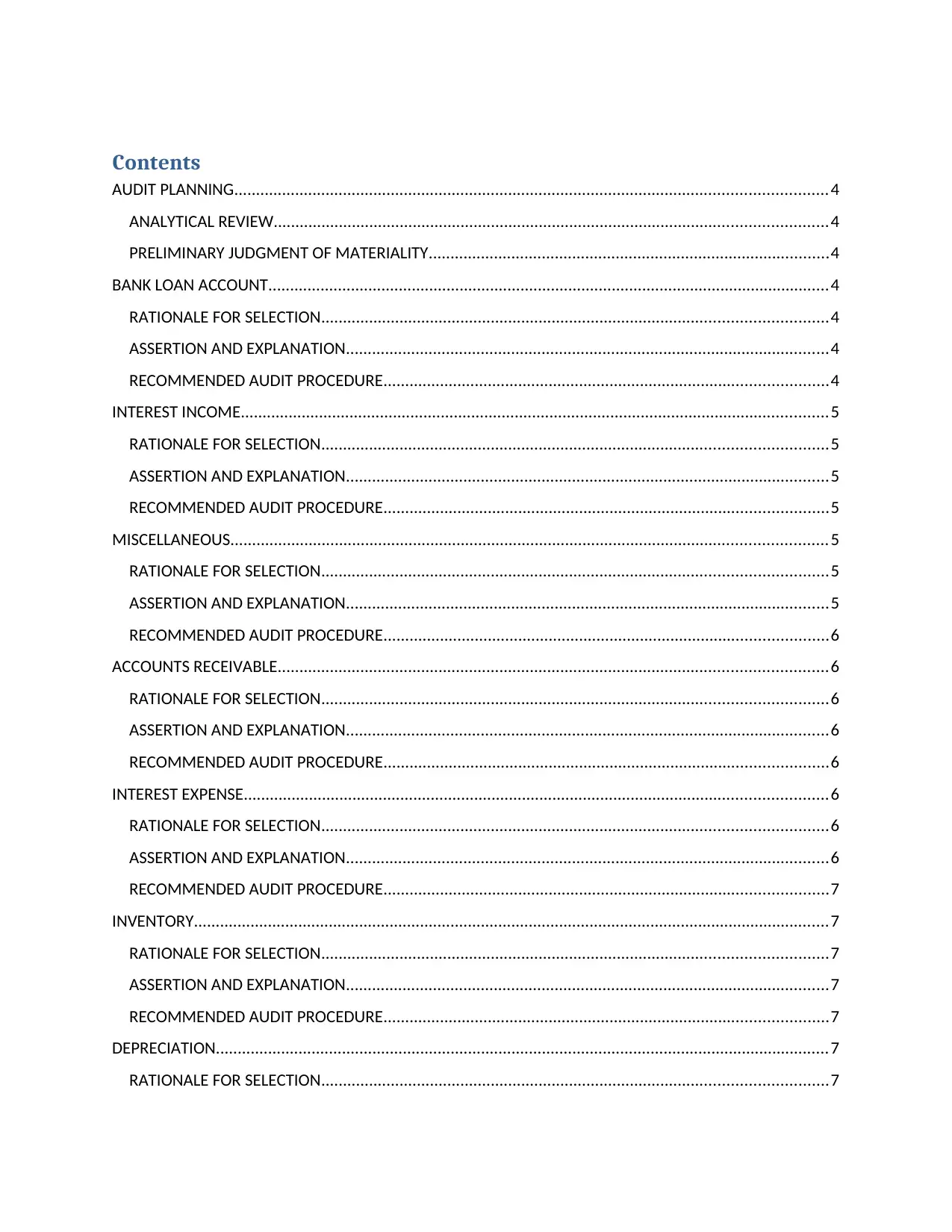
Contents
AUDIT PLANNING........................................................................................................................................4
ANALYTICAL REVIEW...............................................................................................................................4
PRELIMINARY JUDGMENT OF MATERIALITY............................................................................................4
BANK LOAN ACCOUNT.................................................................................................................................4
RATIONALE FOR SELECTION....................................................................................................................4
ASSERTION AND EXPLANATION...............................................................................................................4
RECOMMENDED AUDIT PROCEDURE......................................................................................................4
INTEREST INCOME.......................................................................................................................................5
RATIONALE FOR SELECTION....................................................................................................................5
ASSERTION AND EXPLANATION...............................................................................................................5
RECOMMENDED AUDIT PROCEDURE......................................................................................................5
MISCELLANEOUS.........................................................................................................................................5
RATIONALE FOR SELECTION....................................................................................................................5
ASSERTION AND EXPLANATION...............................................................................................................5
RECOMMENDED AUDIT PROCEDURE......................................................................................................6
ACCOUNTS RECEIVABLE..............................................................................................................................6
RATIONALE FOR SELECTION....................................................................................................................6
ASSERTION AND EXPLANATION...............................................................................................................6
RECOMMENDED AUDIT PROCEDURE......................................................................................................6
INTEREST EXPENSE......................................................................................................................................6
RATIONALE FOR SELECTION....................................................................................................................6
ASSERTION AND EXPLANATION...............................................................................................................6
RECOMMENDED AUDIT PROCEDURE......................................................................................................7
INVENTORY..................................................................................................................................................7
RATIONALE FOR SELECTION....................................................................................................................7
ASSERTION AND EXPLANATION...............................................................................................................7
RECOMMENDED AUDIT PROCEDURE......................................................................................................7
DEPRECIATION.............................................................................................................................................7
RATIONALE FOR SELECTION....................................................................................................................7
AUDIT PLANNING........................................................................................................................................4
ANALYTICAL REVIEW...............................................................................................................................4
PRELIMINARY JUDGMENT OF MATERIALITY............................................................................................4
BANK LOAN ACCOUNT.................................................................................................................................4
RATIONALE FOR SELECTION....................................................................................................................4
ASSERTION AND EXPLANATION...............................................................................................................4
RECOMMENDED AUDIT PROCEDURE......................................................................................................4
INTEREST INCOME.......................................................................................................................................5
RATIONALE FOR SELECTION....................................................................................................................5
ASSERTION AND EXPLANATION...............................................................................................................5
RECOMMENDED AUDIT PROCEDURE......................................................................................................5
MISCELLANEOUS.........................................................................................................................................5
RATIONALE FOR SELECTION....................................................................................................................5
ASSERTION AND EXPLANATION...............................................................................................................5
RECOMMENDED AUDIT PROCEDURE......................................................................................................6
ACCOUNTS RECEIVABLE..............................................................................................................................6
RATIONALE FOR SELECTION....................................................................................................................6
ASSERTION AND EXPLANATION...............................................................................................................6
RECOMMENDED AUDIT PROCEDURE......................................................................................................6
INTEREST EXPENSE......................................................................................................................................6
RATIONALE FOR SELECTION....................................................................................................................6
ASSERTION AND EXPLANATION...............................................................................................................6
RECOMMENDED AUDIT PROCEDURE......................................................................................................7
INVENTORY..................................................................................................................................................7
RATIONALE FOR SELECTION....................................................................................................................7
ASSERTION AND EXPLANATION...............................................................................................................7
RECOMMENDED AUDIT PROCEDURE......................................................................................................7
DEPRECIATION.............................................................................................................................................7
RATIONALE FOR SELECTION....................................................................................................................7
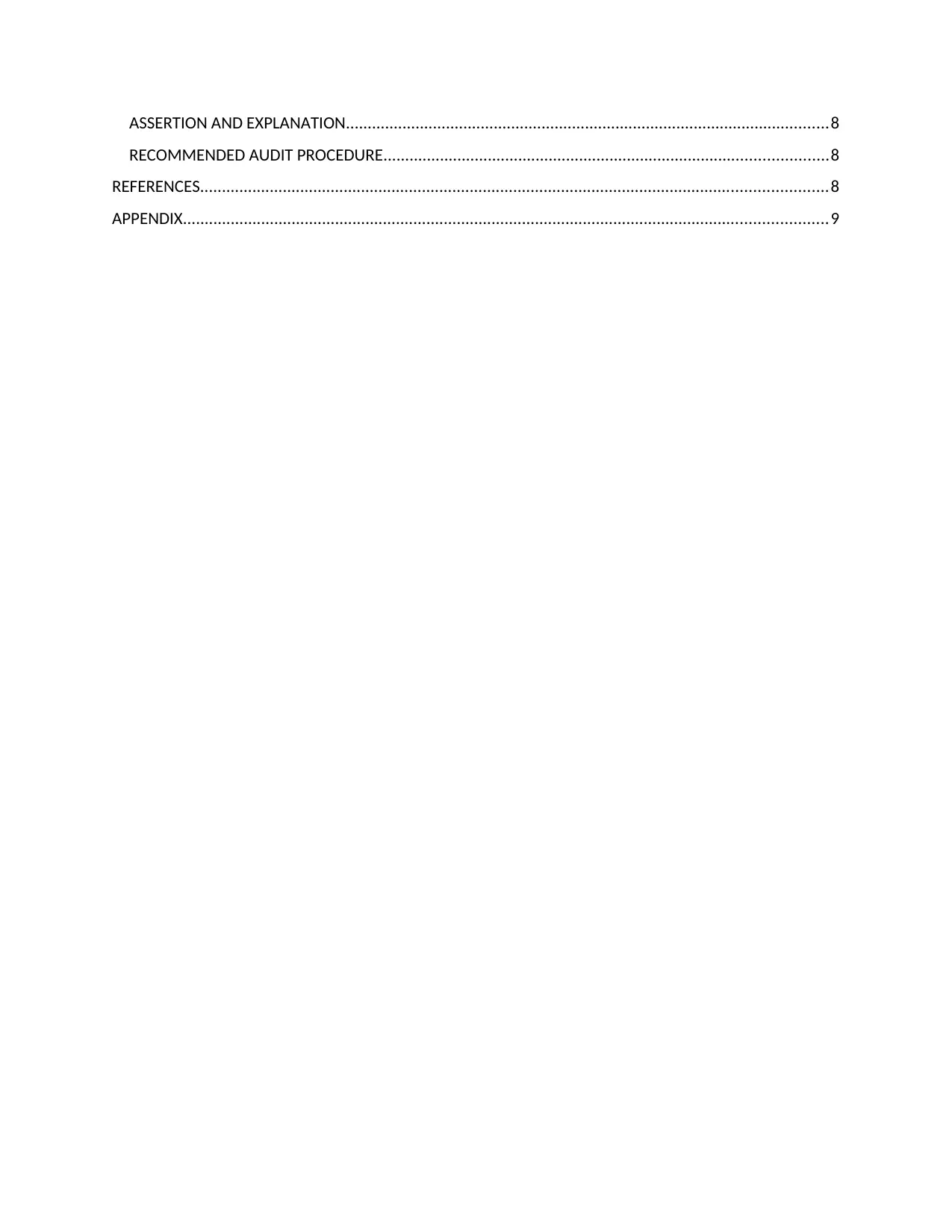
ASSERTION AND EXPLANATION...............................................................................................................8
RECOMMENDED AUDIT PROCEDURE......................................................................................................8
REFERENCES................................................................................................................................................8
APPENDIX....................................................................................................................................................9
RECOMMENDED AUDIT PROCEDURE......................................................................................................8
REFERENCES................................................................................................................................................8
APPENDIX....................................................................................................................................................9
⊘ This is a preview!⊘
Do you want full access?
Subscribe today to unlock all pages.

Trusted by 1+ million students worldwide
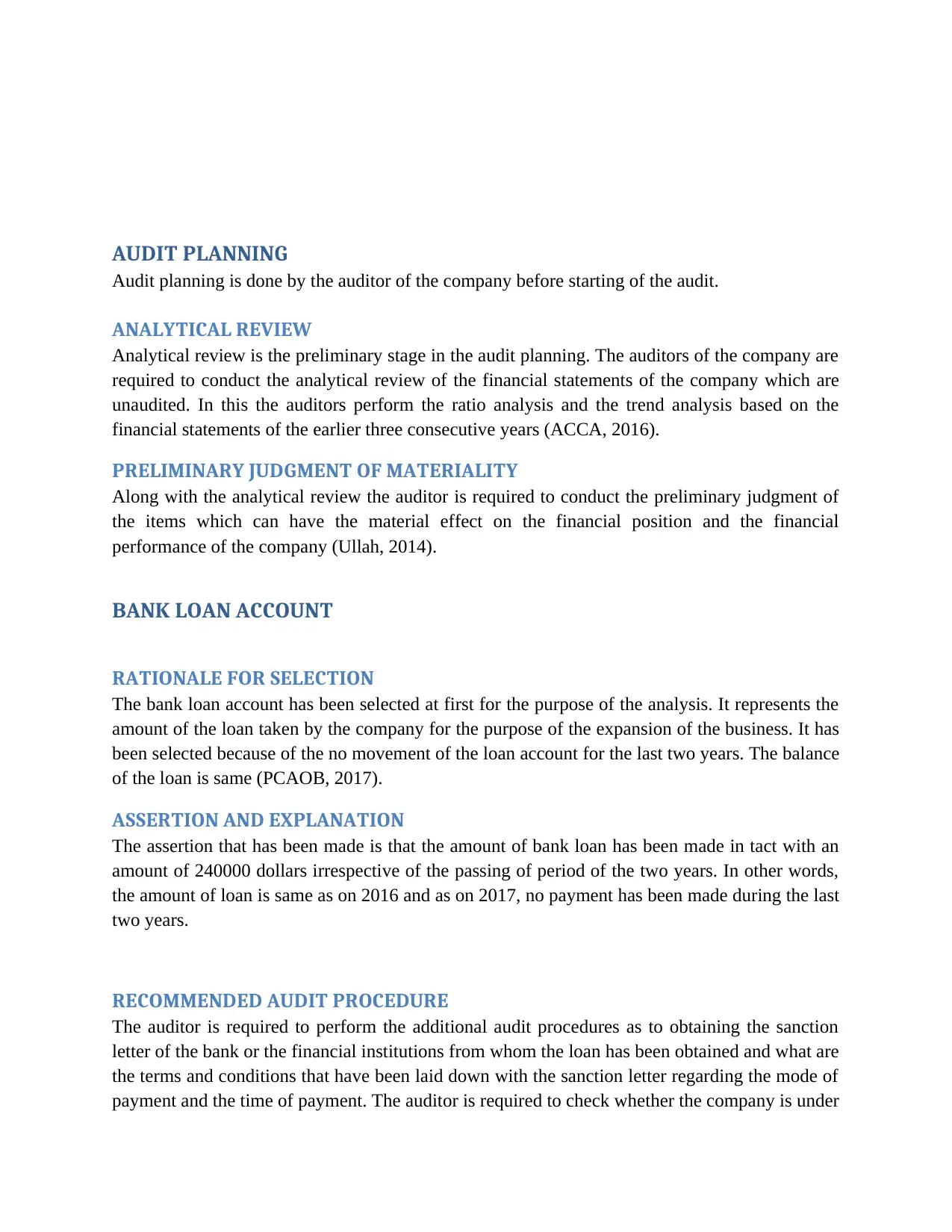
AUDIT PLANNING
Audit planning is done by the auditor of the company before starting of the audit.
ANALYTICAL REVIEW
Analytical review is the preliminary stage in the audit planning. The auditors of the company are
required to conduct the analytical review of the financial statements of the company which are
unaudited. In this the auditors perform the ratio analysis and the trend analysis based on the
financial statements of the earlier three consecutive years (ACCA, 2016).
PRELIMINARY JUDGMENT OF MATERIALITY
Along with the analytical review the auditor is required to conduct the preliminary judgment of
the items which can have the material effect on the financial position and the financial
performance of the company (Ullah, 2014).
BANK LOAN ACCOUNT
RATIONALE FOR SELECTION
The bank loan account has been selected at first for the purpose of the analysis. It represents the
amount of the loan taken by the company for the purpose of the expansion of the business. It has
been selected because of the no movement of the loan account for the last two years. The balance
of the loan is same (PCAOB, 2017).
ASSERTION AND EXPLANATION
The assertion that has been made is that the amount of bank loan has been made in tact with an
amount of 240000 dollars irrespective of the passing of period of the two years. In other words,
the amount of loan is same as on 2016 and as on 2017, no payment has been made during the last
two years.
RECOMMENDED AUDIT PROCEDURE
The auditor is required to perform the additional audit procedures as to obtaining the sanction
letter of the bank or the financial institutions from whom the loan has been obtained and what are
the terms and conditions that have been laid down with the sanction letter regarding the mode of
payment and the time of payment. The auditor is required to check whether the company is under
Audit planning is done by the auditor of the company before starting of the audit.
ANALYTICAL REVIEW
Analytical review is the preliminary stage in the audit planning. The auditors of the company are
required to conduct the analytical review of the financial statements of the company which are
unaudited. In this the auditors perform the ratio analysis and the trend analysis based on the
financial statements of the earlier three consecutive years (ACCA, 2016).
PRELIMINARY JUDGMENT OF MATERIALITY
Along with the analytical review the auditor is required to conduct the preliminary judgment of
the items which can have the material effect on the financial position and the financial
performance of the company (Ullah, 2014).
BANK LOAN ACCOUNT
RATIONALE FOR SELECTION
The bank loan account has been selected at first for the purpose of the analysis. It represents the
amount of the loan taken by the company for the purpose of the expansion of the business. It has
been selected because of the no movement of the loan account for the last two years. The balance
of the loan is same (PCAOB, 2017).
ASSERTION AND EXPLANATION
The assertion that has been made is that the amount of bank loan has been made in tact with an
amount of 240000 dollars irrespective of the passing of period of the two years. In other words,
the amount of loan is same as on 2016 and as on 2017, no payment has been made during the last
two years.
RECOMMENDED AUDIT PROCEDURE
The auditor is required to perform the additional audit procedures as to obtaining the sanction
letter of the bank or the financial institutions from whom the loan has been obtained and what are
the terms and conditions that have been laid down with the sanction letter regarding the mode of
payment and the time of payment. The auditor is required to check whether the company is under
Paraphrase This Document
Need a fresh take? Get an instant paraphrase of this document with our AI Paraphraser
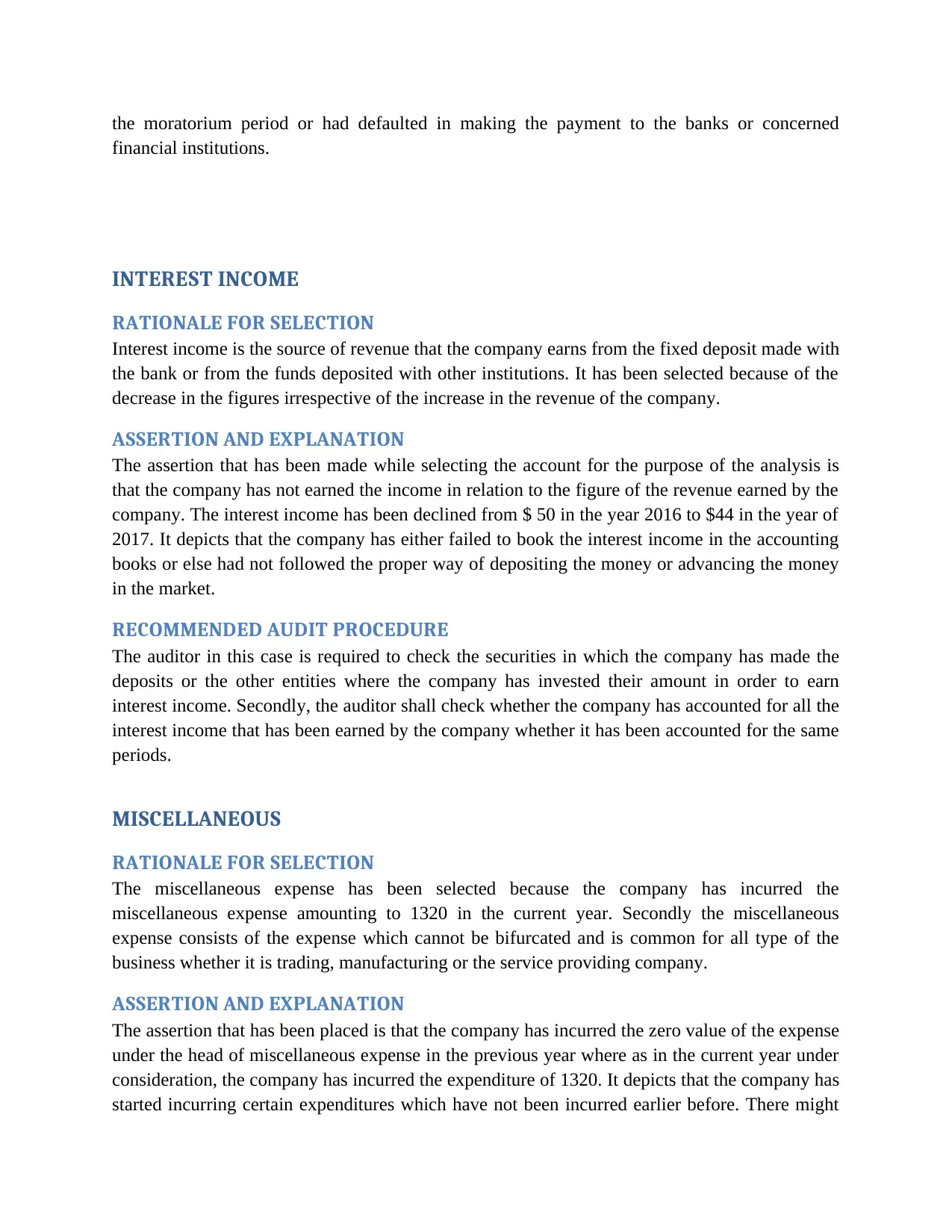
the moratorium period or had defaulted in making the payment to the banks or concerned
financial institutions.
INTEREST INCOME
RATIONALE FOR SELECTION
Interest income is the source of revenue that the company earns from the fixed deposit made with
the bank or from the funds deposited with other institutions. It has been selected because of the
decrease in the figures irrespective of the increase in the revenue of the company.
ASSERTION AND EXPLANATION
The assertion that has been made while selecting the account for the purpose of the analysis is
that the company has not earned the income in relation to the figure of the revenue earned by the
company. The interest income has been declined from $ 50 in the year 2016 to $44 in the year of
2017. It depicts that the company has either failed to book the interest income in the accounting
books or else had not followed the proper way of depositing the money or advancing the money
in the market.
RECOMMENDED AUDIT PROCEDURE
The auditor in this case is required to check the securities in which the company has made the
deposits or the other entities where the company has invested their amount in order to earn
interest income. Secondly, the auditor shall check whether the company has accounted for all the
interest income that has been earned by the company whether it has been accounted for the same
periods.
MISCELLANEOUS
RATIONALE FOR SELECTION
The miscellaneous expense has been selected because the company has incurred the
miscellaneous expense amounting to 1320 in the current year. Secondly the miscellaneous
expense consists of the expense which cannot be bifurcated and is common for all type of the
business whether it is trading, manufacturing or the service providing company.
ASSERTION AND EXPLANATION
The assertion that has been placed is that the company has incurred the zero value of the expense
under the head of miscellaneous expense in the previous year where as in the current year under
consideration, the company has incurred the expenditure of 1320. It depicts that the company has
started incurring certain expenditures which have not been incurred earlier before. There might
financial institutions.
INTEREST INCOME
RATIONALE FOR SELECTION
Interest income is the source of revenue that the company earns from the fixed deposit made with
the bank or from the funds deposited with other institutions. It has been selected because of the
decrease in the figures irrespective of the increase in the revenue of the company.
ASSERTION AND EXPLANATION
The assertion that has been made while selecting the account for the purpose of the analysis is
that the company has not earned the income in relation to the figure of the revenue earned by the
company. The interest income has been declined from $ 50 in the year 2016 to $44 in the year of
2017. It depicts that the company has either failed to book the interest income in the accounting
books or else had not followed the proper way of depositing the money or advancing the money
in the market.
RECOMMENDED AUDIT PROCEDURE
The auditor in this case is required to check the securities in which the company has made the
deposits or the other entities where the company has invested their amount in order to earn
interest income. Secondly, the auditor shall check whether the company has accounted for all the
interest income that has been earned by the company whether it has been accounted for the same
periods.
MISCELLANEOUS
RATIONALE FOR SELECTION
The miscellaneous expense has been selected because the company has incurred the
miscellaneous expense amounting to 1320 in the current year. Secondly the miscellaneous
expense consists of the expense which cannot be bifurcated and is common for all type of the
business whether it is trading, manufacturing or the service providing company.
ASSERTION AND EXPLANATION
The assertion that has been placed is that the company has incurred the zero value of the expense
under the head of miscellaneous expense in the previous year where as in the current year under
consideration, the company has incurred the expenditure of 1320. It depicts that the company has
started incurring certain expenditures which have not been incurred earlier before. There might
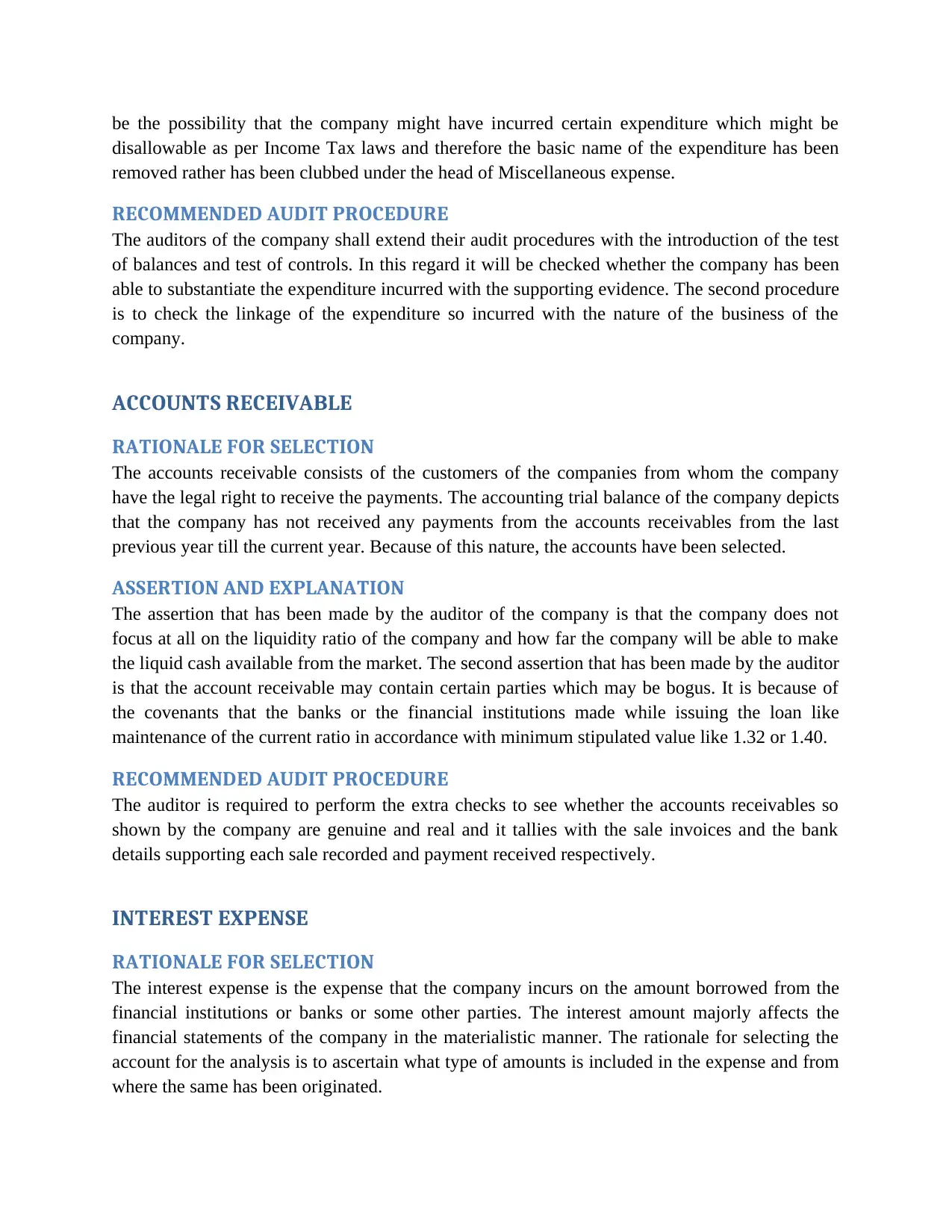
be the possibility that the company might have incurred certain expenditure which might be
disallowable as per Income Tax laws and therefore the basic name of the expenditure has been
removed rather has been clubbed under the head of Miscellaneous expense.
RECOMMENDED AUDIT PROCEDURE
The auditors of the company shall extend their audit procedures with the introduction of the test
of balances and test of controls. In this regard it will be checked whether the company has been
able to substantiate the expenditure incurred with the supporting evidence. The second procedure
is to check the linkage of the expenditure so incurred with the nature of the business of the
company.
ACCOUNTS RECEIVABLE
RATIONALE FOR SELECTION
The accounts receivable consists of the customers of the companies from whom the company
have the legal right to receive the payments. The accounting trial balance of the company depicts
that the company has not received any payments from the accounts receivables from the last
previous year till the current year. Because of this nature, the accounts have been selected.
ASSERTION AND EXPLANATION
The assertion that has been made by the auditor of the company is that the company does not
focus at all on the liquidity ratio of the company and how far the company will be able to make
the liquid cash available from the market. The second assertion that has been made by the auditor
is that the account receivable may contain certain parties which may be bogus. It is because of
the covenants that the banks or the financial institutions made while issuing the loan like
maintenance of the current ratio in accordance with minimum stipulated value like 1.32 or 1.40.
RECOMMENDED AUDIT PROCEDURE
The auditor is required to perform the extra checks to see whether the accounts receivables so
shown by the company are genuine and real and it tallies with the sale invoices and the bank
details supporting each sale recorded and payment received respectively.
INTEREST EXPENSE
RATIONALE FOR SELECTION
The interest expense is the expense that the company incurs on the amount borrowed from the
financial institutions or banks or some other parties. The interest amount majorly affects the
financial statements of the company in the materialistic manner. The rationale for selecting the
account for the analysis is to ascertain what type of amounts is included in the expense and from
where the same has been originated.
disallowable as per Income Tax laws and therefore the basic name of the expenditure has been
removed rather has been clubbed under the head of Miscellaneous expense.
RECOMMENDED AUDIT PROCEDURE
The auditors of the company shall extend their audit procedures with the introduction of the test
of balances and test of controls. In this regard it will be checked whether the company has been
able to substantiate the expenditure incurred with the supporting evidence. The second procedure
is to check the linkage of the expenditure so incurred with the nature of the business of the
company.
ACCOUNTS RECEIVABLE
RATIONALE FOR SELECTION
The accounts receivable consists of the customers of the companies from whom the company
have the legal right to receive the payments. The accounting trial balance of the company depicts
that the company has not received any payments from the accounts receivables from the last
previous year till the current year. Because of this nature, the accounts have been selected.
ASSERTION AND EXPLANATION
The assertion that has been made by the auditor of the company is that the company does not
focus at all on the liquidity ratio of the company and how far the company will be able to make
the liquid cash available from the market. The second assertion that has been made by the auditor
is that the account receivable may contain certain parties which may be bogus. It is because of
the covenants that the banks or the financial institutions made while issuing the loan like
maintenance of the current ratio in accordance with minimum stipulated value like 1.32 or 1.40.
RECOMMENDED AUDIT PROCEDURE
The auditor is required to perform the extra checks to see whether the accounts receivables so
shown by the company are genuine and real and it tallies with the sale invoices and the bank
details supporting each sale recorded and payment received respectively.
INTEREST EXPENSE
RATIONALE FOR SELECTION
The interest expense is the expense that the company incurs on the amount borrowed from the
financial institutions or banks or some other parties. The interest amount majorly affects the
financial statements of the company in the materialistic manner. The rationale for selecting the
account for the analysis is to ascertain what type of amounts is included in the expense and from
where the same has been originated.
⊘ This is a preview!⊘
Do you want full access?
Subscribe today to unlock all pages.

Trusted by 1+ million students worldwide
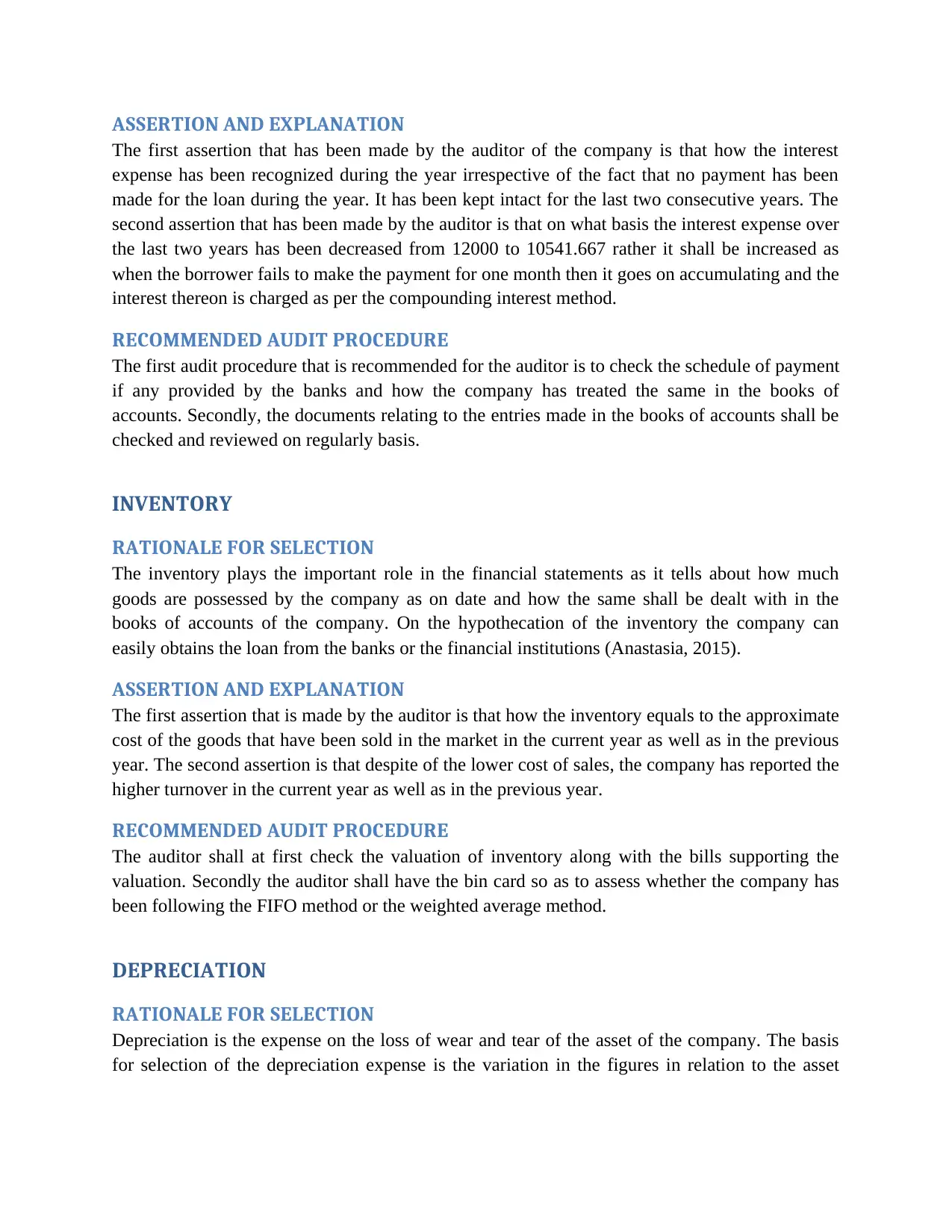
ASSERTION AND EXPLANATION
The first assertion that has been made by the auditor of the company is that how the interest
expense has been recognized during the year irrespective of the fact that no payment has been
made for the loan during the year. It has been kept intact for the last two consecutive years. The
second assertion that has been made by the auditor is that on what basis the interest expense over
the last two years has been decreased from 12000 to 10541.667 rather it shall be increased as
when the borrower fails to make the payment for one month then it goes on accumulating and the
interest thereon is charged as per the compounding interest method.
RECOMMENDED AUDIT PROCEDURE
The first audit procedure that is recommended for the auditor is to check the schedule of payment
if any provided by the banks and how the company has treated the same in the books of
accounts. Secondly, the documents relating to the entries made in the books of accounts shall be
checked and reviewed on regularly basis.
INVENTORY
RATIONALE FOR SELECTION
The inventory plays the important role in the financial statements as it tells about how much
goods are possessed by the company as on date and how the same shall be dealt with in the
books of accounts of the company. On the hypothecation of the inventory the company can
easily obtains the loan from the banks or the financial institutions (Anastasia, 2015).
ASSERTION AND EXPLANATION
The first assertion that is made by the auditor is that how the inventory equals to the approximate
cost of the goods that have been sold in the market in the current year as well as in the previous
year. The second assertion is that despite of the lower cost of sales, the company has reported the
higher turnover in the current year as well as in the previous year.
RECOMMENDED AUDIT PROCEDURE
The auditor shall at first check the valuation of inventory along with the bills supporting the
valuation. Secondly the auditor shall have the bin card so as to assess whether the company has
been following the FIFO method or the weighted average method.
DEPRECIATION
RATIONALE FOR SELECTION
Depreciation is the expense on the loss of wear and tear of the asset of the company. The basis
for selection of the depreciation expense is the variation in the figures in relation to the asset
The first assertion that has been made by the auditor of the company is that how the interest
expense has been recognized during the year irrespective of the fact that no payment has been
made for the loan during the year. It has been kept intact for the last two consecutive years. The
second assertion that has been made by the auditor is that on what basis the interest expense over
the last two years has been decreased from 12000 to 10541.667 rather it shall be increased as
when the borrower fails to make the payment for one month then it goes on accumulating and the
interest thereon is charged as per the compounding interest method.
RECOMMENDED AUDIT PROCEDURE
The first audit procedure that is recommended for the auditor is to check the schedule of payment
if any provided by the banks and how the company has treated the same in the books of
accounts. Secondly, the documents relating to the entries made in the books of accounts shall be
checked and reviewed on regularly basis.
INVENTORY
RATIONALE FOR SELECTION
The inventory plays the important role in the financial statements as it tells about how much
goods are possessed by the company as on date and how the same shall be dealt with in the
books of accounts of the company. On the hypothecation of the inventory the company can
easily obtains the loan from the banks or the financial institutions (Anastasia, 2015).
ASSERTION AND EXPLANATION
The first assertion that is made by the auditor is that how the inventory equals to the approximate
cost of the goods that have been sold in the market in the current year as well as in the previous
year. The second assertion is that despite of the lower cost of sales, the company has reported the
higher turnover in the current year as well as in the previous year.
RECOMMENDED AUDIT PROCEDURE
The auditor shall at first check the valuation of inventory along with the bills supporting the
valuation. Secondly the auditor shall have the bin card so as to assess whether the company has
been following the FIFO method or the weighted average method.
DEPRECIATION
RATIONALE FOR SELECTION
Depreciation is the expense on the loss of wear and tear of the asset of the company. The basis
for selection of the depreciation expense is the variation in the figures in relation to the asset
Paraphrase This Document
Need a fresh take? Get an instant paraphrase of this document with our AI Paraphraser
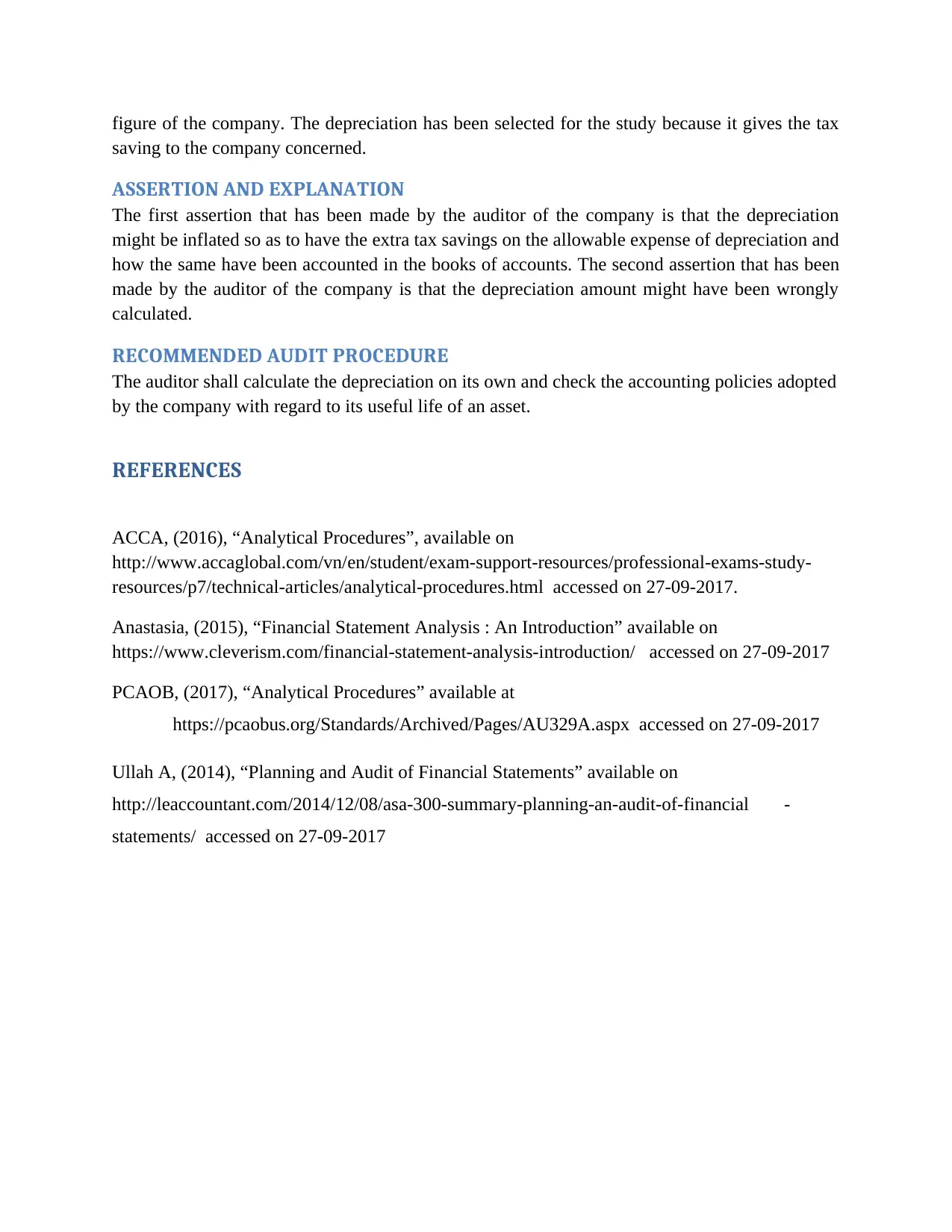
figure of the company. The depreciation has been selected for the study because it gives the tax
saving to the company concerned.
ASSERTION AND EXPLANATION
The first assertion that has been made by the auditor of the company is that the depreciation
might be inflated so as to have the extra tax savings on the allowable expense of depreciation and
how the same have been accounted in the books of accounts. The second assertion that has been
made by the auditor of the company is that the depreciation amount might have been wrongly
calculated.
RECOMMENDED AUDIT PROCEDURE
The auditor shall calculate the depreciation on its own and check the accounting policies adopted
by the company with regard to its useful life of an asset.
REFERENCES
ACCA, (2016), “Analytical Procedures”, available on
http://www.accaglobal.com/vn/en/student/exam-support-resources/professional-exams-study-
resources/p7/technical-articles/analytical-procedures.html accessed on 27-09-2017.
Anastasia, (2015), “Financial Statement Analysis : An Introduction” available on
https://www.cleverism.com/financial-statement-analysis-introduction/ accessed on 27-09-2017
PCAOB, (2017), “Analytical Procedures” available at
https://pcaobus.org/Standards/Archived/Pages/AU329A.aspx accessed on 27-09-2017
Ullah A, (2014), “Planning and Audit of Financial Statements” available on
http://leaccountant.com/2014/12/08/asa-300-summary-planning-an-audit-of-financial -
statements/ accessed on 27-09-2017
saving to the company concerned.
ASSERTION AND EXPLANATION
The first assertion that has been made by the auditor of the company is that the depreciation
might be inflated so as to have the extra tax savings on the allowable expense of depreciation and
how the same have been accounted in the books of accounts. The second assertion that has been
made by the auditor of the company is that the depreciation amount might have been wrongly
calculated.
RECOMMENDED AUDIT PROCEDURE
The auditor shall calculate the depreciation on its own and check the accounting policies adopted
by the company with regard to its useful life of an asset.
REFERENCES
ACCA, (2016), “Analytical Procedures”, available on
http://www.accaglobal.com/vn/en/student/exam-support-resources/professional-exams-study-
resources/p7/technical-articles/analytical-procedures.html accessed on 27-09-2017.
Anastasia, (2015), “Financial Statement Analysis : An Introduction” available on
https://www.cleverism.com/financial-statement-analysis-introduction/ accessed on 27-09-2017
PCAOB, (2017), “Analytical Procedures” available at
https://pcaobus.org/Standards/Archived/Pages/AU329A.aspx accessed on 27-09-2017
Ullah A, (2014), “Planning and Audit of Financial Statements” available on
http://leaccountant.com/2014/12/08/asa-300-summary-planning-an-audit-of-financial -
statements/ accessed on 27-09-2017
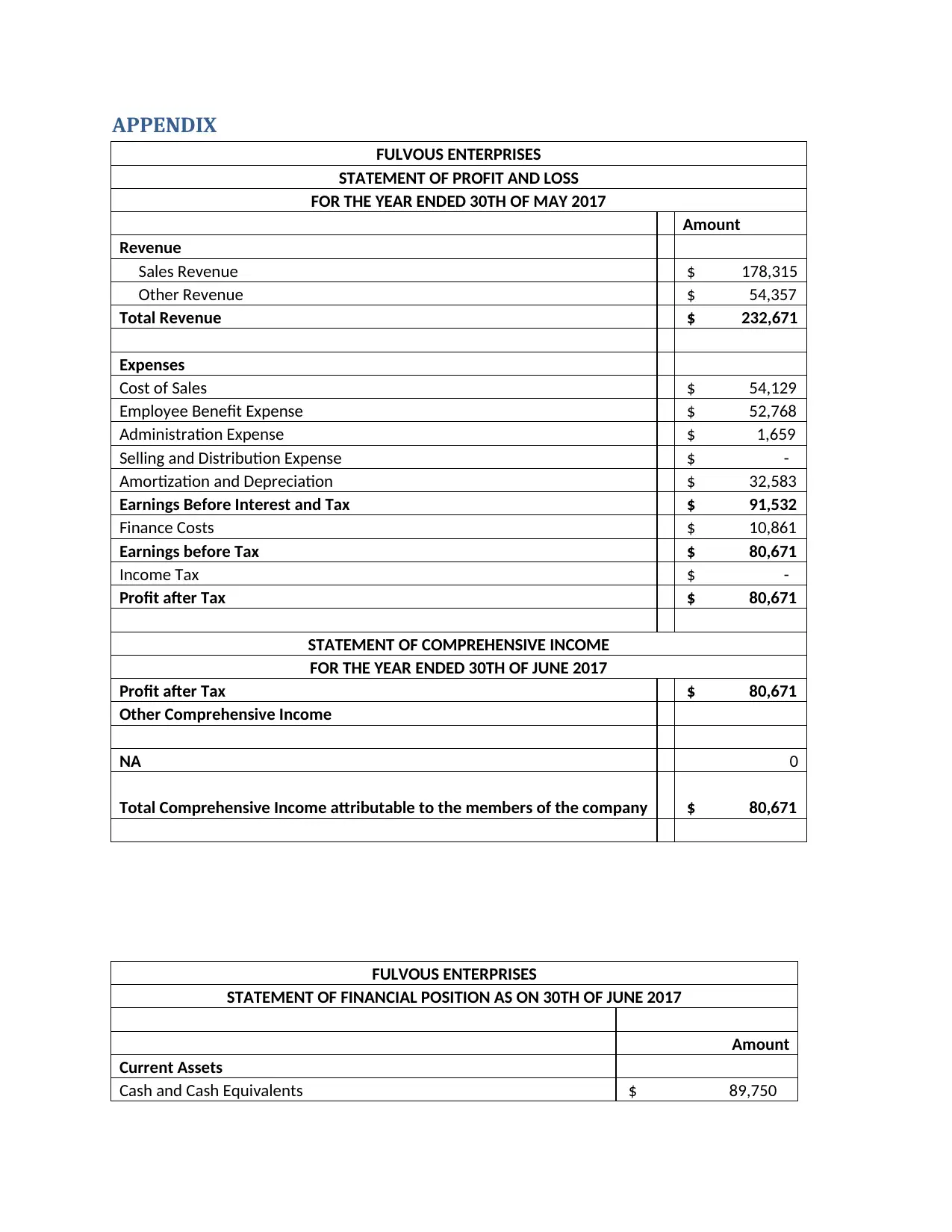
APPENDIX
FULVOUS ENTERPRISES
STATEMENT OF PROFIT AND LOSS
FOR THE YEAR ENDED 30TH OF MAY 2017
Amount
Revenue
Sales Revenue $ 178,315
Other Revenue $ 54,357
Total Revenue $ 232,671
Expenses
Cost of Sales $ 54,129
Employee Benefit Expense $ 52,768
Administration Expense $ 1,659
Selling and Distribution Expense $ -
Amortization and Depreciation $ 32,583
Earnings Before Interest and Tax $ 91,532
Finance Costs $ 10,861
Earnings before Tax $ 80,671
Income Tax $ -
Profit after Tax $ 80,671
STATEMENT OF COMPREHENSIVE INCOME
FOR THE YEAR ENDED 30TH OF JUNE 2017
Profit after Tax $ 80,671
Other Comprehensive Income
NA 0
Total Comprehensive Income attributable to the members of the company $ 80,671
FULVOUS ENTERPRISES
STATEMENT OF FINANCIAL POSITION AS ON 30TH OF JUNE 2017
Amount
Current Assets
Cash and Cash Equivalents $ 89,750
FULVOUS ENTERPRISES
STATEMENT OF PROFIT AND LOSS
FOR THE YEAR ENDED 30TH OF MAY 2017
Amount
Revenue
Sales Revenue $ 178,315
Other Revenue $ 54,357
Total Revenue $ 232,671
Expenses
Cost of Sales $ 54,129
Employee Benefit Expense $ 52,768
Administration Expense $ 1,659
Selling and Distribution Expense $ -
Amortization and Depreciation $ 32,583
Earnings Before Interest and Tax $ 91,532
Finance Costs $ 10,861
Earnings before Tax $ 80,671
Income Tax $ -
Profit after Tax $ 80,671
STATEMENT OF COMPREHENSIVE INCOME
FOR THE YEAR ENDED 30TH OF JUNE 2017
Profit after Tax $ 80,671
Other Comprehensive Income
NA 0
Total Comprehensive Income attributable to the members of the company $ 80,671
FULVOUS ENTERPRISES
STATEMENT OF FINANCIAL POSITION AS ON 30TH OF JUNE 2017
Amount
Current Assets
Cash and Cash Equivalents $ 89,750
⊘ This is a preview!⊘
Do you want full access?
Subscribe today to unlock all pages.

Trusted by 1+ million students worldwide
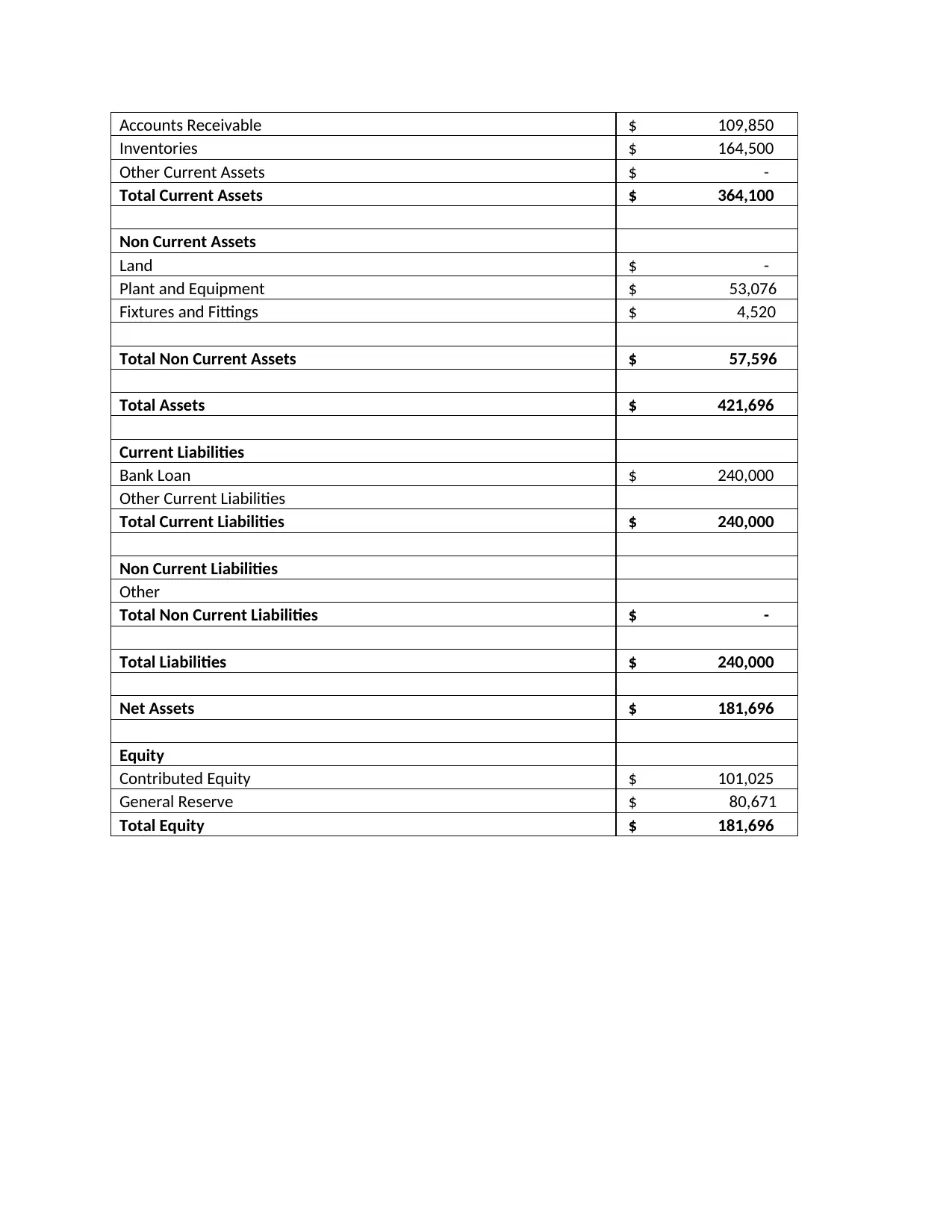
Accounts Receivable $ 109,850
Inventories $ 164,500
Other Current Assets $ -
Total Current Assets $ 364,100
Non Current Assets
Land $ -
Plant and Equipment $ 53,076
Fixtures and Fittings $ 4,520
Total Non Current Assets $ 57,596
Total Assets $ 421,696
Current Liabilities
Bank Loan $ 240,000
Other Current Liabilities
Total Current Liabilities $ 240,000
Non Current Liabilities
Other
Total Non Current Liabilities $ -
Total Liabilities $ 240,000
Net Assets $ 181,696
Equity
Contributed Equity $ 101,025
General Reserve $ 80,671
Total Equity $ 181,696
Inventories $ 164,500
Other Current Assets $ -
Total Current Assets $ 364,100
Non Current Assets
Land $ -
Plant and Equipment $ 53,076
Fixtures and Fittings $ 4,520
Total Non Current Assets $ 57,596
Total Assets $ 421,696
Current Liabilities
Bank Loan $ 240,000
Other Current Liabilities
Total Current Liabilities $ 240,000
Non Current Liabilities
Other
Total Non Current Liabilities $ -
Total Liabilities $ 240,000
Net Assets $ 181,696
Equity
Contributed Equity $ 101,025
General Reserve $ 80,671
Total Equity $ 181,696
1 out of 10
Related Documents
Your All-in-One AI-Powered Toolkit for Academic Success.
+13062052269
info@desklib.com
Available 24*7 on WhatsApp / Email
![[object Object]](/_next/static/media/star-bottom.7253800d.svg)
Unlock your academic potential
Copyright © 2020–2025 A2Z Services. All Rights Reserved. Developed and managed by ZUCOL.





